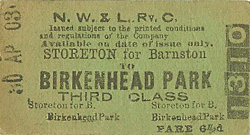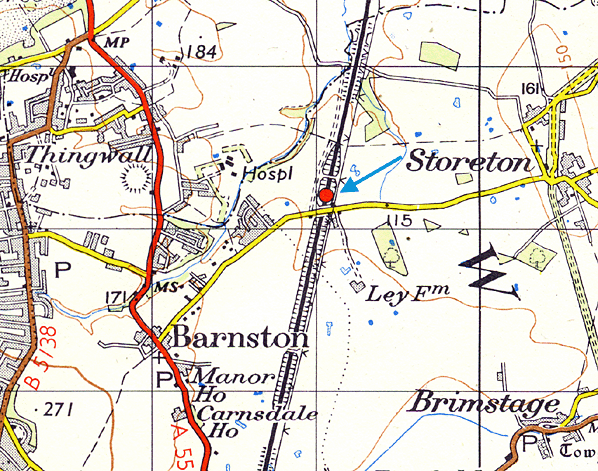| Notes: Storeton station was situated on the North Wales & Liverpool Railway Committee’s (NW&LRC) line between Hawarden Bridge with Bidston. The NW&LRC was a joint concern consisting of the Manchester, Sheffield & Lincolnshire Railway (MS&LR) and the Wrexham, Mold and Connah's Quay Railway (WM&CQR). The MS&LR had |
 |
opened a line from Chester Northgate to the south bank of the River Dee via Hawarden Bridge on 31st March 1890.
 |
The line made on end-on connection with the WM&CQR whose line from Buckley to the River Dee had opened a few days earlier. At Buckley it connected with the original WM&CQR line of 1866 which gave access to Wrexham. A through route had thereby been created between Chester and Wrexham that could compete with the Great Western Railway (GWR).
The MS&LR had ambitions to reach the River Mersey at Birkenhead for which reason that they lured the WM&CQR into the what was first called the Dee & Birkenhead Committee (D&BC) venture to build a line to Bidston on the Wirral Railway’s (WR) network. The WR had originally proposed a line to link with the WM&CQR, and they had even received an Act to build it, but they failed to raise the capital. They were happy therefore to offer running rights over their network to the D&BC.
Work on the line began on 21st October 1892 and it opened on 18th May 1896. Storeton station opened with the line, but was originally known as Barnston. On 7th August 1896 the D&BC became the NW&LRC and on 1st August 1897 the MS&LR changed its name to the Great Central Railway.
Barnston station was in a fairly isolated position just under a mile east of Barnston village, and a mile west of Storeton village. The station was positioned in a shallow cutting on the north side of Station Road. The line was double-track so the station was provided with two platforms. The booking facilities were in a brick over-track building at street level. Steps led down to the platforms on each side of the building. Both platforms had single-storey brick buildings at about the mid-point, and opposite each other. The buildings |
provided waiting facilities and toilets.
The goods yard was sited on the down side of the line south of Station Road and comprised two sidings running parrallel with the line. One of the sidings was very short and served a cattle dock with a cattle pen at its southern end. A signal box, also on the down side, alongside the siding controlled access.
 |
At the time of opening Barnston was served by trains between Wrexham Central and Bidston and between Chester Northgate and Bidston. The trains were the responsibility of the NW&LRC but were worked by MS&LR (after August 1897 GCR) locomotives. The NW&LRC intended to run trains direct to Liverpool Central via the WR and the Mersey Railway (MR) |
under the river between Liverpool and Birkenhead. Some excursions did run, but the MR proved uncooperative, and running rights for regular services could not be agreed. In 1897 the WM&CQR went into receivership; their involvement in the NW&LRC had bankrupted them.
From 1898 the NW&LRC services running northwards were extended to Seacombe, a WR station on the west bank of the Mersey, opposite Liverpool, in the town of Wallasey. A ferry service between Seacombe to Liverpool connected with trains. Through tickets were also issued, and in timetables the arrival and departure times from |
 |
Liverpool Landing Stage were given. The idea of running into Liverpool via the MR was dropped and, in any event, in 1903 the MR was electrified and no steam workings were permitted.
On 1st May 1900 Barnston station was renamed Storeton for Barnston. On 1st January 1905 the GCR formally absorbed the insolvent WM&CQR, and the NW&LRC was no more. Storeton and the lines between Wrexham Central, Chester Northgate and Bidston became purely GCR.
 |
In April 1910 the GCR was operating eight trains to Wrexham Central from Storeton - although one was by request only - four to Chester Northgate and fourteen to Seacombe on weekdays. There was an extra service to Penyffordd on Wednesdays only. The first weekday departure for Seacombe was at 8.14am. The first southbound departure was for Wrexham |
Central at 8.09am. The last departure on weekdays was for Seacombe at 10.01pm. On Sundays there were three trains to Wrexham Central, two to Chester and five to Seacombe.
On 1st January 1923 Storeton for Barnston became a London & North Eastern Railway (LNER) station. In 1933 they officially dropped the ‘for Barnston’ suffix, yet both Bradshaw and the LNER timetable continued to call the station Storeton for Barnston, as did British Railways until its closure. By September 1937 the LNER was running ten trains to Wrexham Central between Monday and Friday and fourteen on |
 |
Saturdays. The first Wrexham Central departure was at 8.03am and the last was at 9:55pm Monday to Friday and at 11:24pm on Saturdays. Two trains also ran to Connahs Quay and Shotton between Monday and Saturday. To Seacombe there were twelve Monday to Friday services and thirteen on Saturdays. The first departure was at 7.45am and the last was at 10.12pm. No trains called at Storeton on Sundays.
 |
On 1st January 1948 Storeton became part of the nationalised British Railways Eastern Region, but some months later the ex-LNER lines in NE Wales and the Wirral were transferred to the London Midland Region. By June 1950 British Railways were operating seven trains to Wrexham Central between Monday and Friday and nine on Saturdays. The first left Storeton at |
7.38am and the last left at 9.54pm. There were also four trains to Connah’s Quay and Shotton between Monday and Saturday. To Seacombe there were twelve trains Monday to Friday and fourteen on Saturdays. The first Seacombe departure was at 7.35am and the last at 9:56pm Monday to Friday and 10.27 on Saturdays. There were still no Sunday services by 1950.
.
Being isolated, and at some distance from nearby villages, Storeton suffered from the effects of road competition. British Railways closed the station to passengers on 3rd December 1951; it remained open for goods until 3rd February 1964. After complete closure it was demolished, and nothing remained of it in 2011. The goods yard has now been put to industrial |
 |
use. The line itself remained open to passenger and goods services after the station’s closure, but by March 2011 the section through Storeton had no scheduled goods services. An hourly passenger service in each direction was operated by Arriva Trains Wales as part of the Borderlands service connecting Wrexham and Bidston.
Ticket from Michael Stewart, Bradshaw from Chris Hind, route map drawn by Alan Young
Sources:
To see other stations on the Wrexham Central to Bidston Line click
Wrexham Central, Wrexham Exchange, Rhosddu, Hope High Level, Buckley (1st station), Chester Golf Club Halt, Birkenhead Junction Golf Club Platform, Sealand Rifle Range Halt, Burton Point
See also
Liscard & Poulton, Seacombe
See also MS&LR Stations between Shotton and Chester Northgate
Chester Junction Golf Club Platform, Sealand, Saughall, Blacon, Chester Liverpool Road, Chester Northgate
See also related items
The Buckley Railway
Hawarden Loop
Hawarden Bridge
Railways at Bidston |

old1.jpg)





 Home Page
Home Page 









